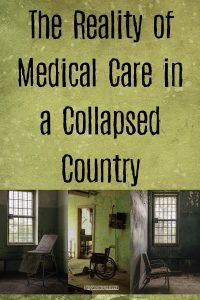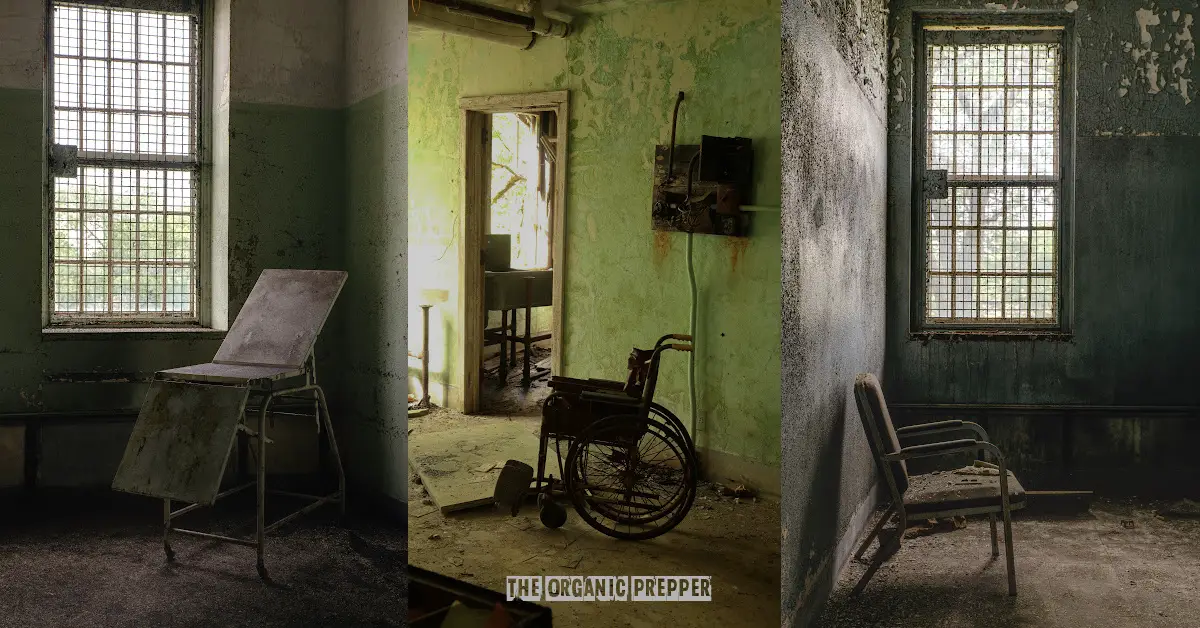(Psst: The FTC wants me to remind you that this website contains affiliate links. That means if you make a purchase from a link you click on, I might receive a small commission. This does not increase the price you’ll pay for that item nor does it decrease the awesomeness of the item. ~ Daisy)
This is nothing easy, nor pleasant to write about.
I won’t sugarcoat anything, because there is no way to do it.
I had an accident and lost part of a finger with a wood planer.
There will be no images, but in the future, you will have proof of this, so you can verify that indeed happened. For the time being, the wound is too gross to show it. Please indulge me on that one.
I had years with that tool, though, and it was an unfortunate distraction.
However, it has been a painful lesson and an eye-opener.
I don’t want to even think if this would have happened back in 2016 when getting antibiotics was easily 500% more expensive.
I needed help.
Once the event happened, I didn’t even have the clarity of mind to call 911. I went out of the house, trembling, and called for help from some contractors who were laboring in some neighbors’ homes. Then I went inside to look for my keys, poured some tap water over the wound, got some toilet paper, wrapped my finger with it, grabbed a jar of oxygenated water, and cleaned the wound again. I was sweating incredibly and close to fainting, so I opened the fridge, and poured two glasses of water, drinking them one after another, to supply the lost blood and hydrate myself.
One of the neighbors promptly came in, rushing me to get on his truck, which I did. The heat was incredible that day, and it didn’t help. The AC was a blessing, so I could relax a little. My kind neighbor drove me to the nearest ER: the clinic of the oil company employees. They usually attend emergencies for non-employees, so they made me sit on a chair in the waiting room, wrote down my data, and gave me a jab of painkiller. Which was a very pleasant surprise as most of the hospitals in the country lack resources.
This is going to be a point of this article, and I hope those working or with ties to the health industry down here can appreciate and value it, and other people can use it to tune up their preps according to what one can expect when you have a severe injury under SHTF conditions.
Once in the hospital, they gave me a shot of toxoid, and put in my vein an intravenous needle. A couple of antibiotic vials, and some serum to help it go through.
The experience in the ER was awful, though. There was no privacy at all. No curtains dividing the beds, and the place was small, with maybe 15 beds total. I had to sit on a bed where a gentleman was being fixed with a urethral probe, while the serum ended up being inoculated through my vein. It’s not like it was important. The only thing I wanted was to end my procedure and make it home without fainting along the way.
In the wound cleaning room, the experience was painful as heck. The painkiller effect had already passed 3,5 hours later, and it was something to remember. I even surprised myself by not fainting at all.
How I will improve my medical kit
Not having any knowledge of medical supplies, I see how any medicine box supply can improve a lot. Wound cleaning supplies are a MUST. I would seal them in vacuum bags to keep them even safer.
Let’s see:
Medical Supplies:
- Wound Care: Chlorhexidine sponges and sterile saline solution by the dozen are essential for treating severe wounds and post-surgical procedures. (Check out this list)
- Antibiotics, however, are much more difficult to acquire, so I’ll leave that to the specialists. (Daisy recommends this kit with antibiotics from The Wellness Company.)
- Suture supplies. Needles, staples, thread, whatever
- Cicatrization creams and ointments
- Burns ointments
- Topical anesthetics
- Hydrogen peroxide. Lots of it.
But in the area, more is needed. If the following could be accomplished in a community, it would be far better.
Antibiotic Production:
- Small-Scale Advantage: Following the same logic, a small-scale plant is the most cost-effective way to produce antibiotics. This approach not only proves highly profitable now but also positions you well for the foreseeable future, regardless of unforeseen circumstances.
Supply Chain Considerations:
- Long-Term Sustainability: Setting up a robust supply chain is crucial. While raw materials, machinery maintenance, and spare parts require careful management, a well-defined system could enable even remote homesteads to become significant antibiotic providers.
What I learned
This awful experience leaving a permanent mark, brings along these hard lessons:
- You may have an insurance policy, but this is not a guarantee of good healthcare attention. In other countries, I would assume that this could happen if the insurance company suddenly files bankruptcy when 70% of the customers need IUC, for instance. If things are ugly enough, forget about suing, laws, or whatever other processes. Remember 2020.
- Be very, extremely careful if you work with your hands building stuff. Use all the protective gear you may need, and have spares.
- Many times what you read in the media is not the truth. I believed the attention and supplies were deficient, and received a lesson. I had to buy myself the meds and medical materials, like gloves, the wound cleaning sponge with Hydroxiclin, compresses, and other stuff, but generally speaking, medical attention was free, and they provided some medications as well on the first day as part of the procedure. I did have to wait a lot, but it is normal in an overwhelmed mid-sized city hospital.
The wound, despite its severity, is healing well. I’ve changed and cleaned it four times now, and fortunately, there’s no sign of mobility loss in the finger. No unexpected bleeding. The traumatologist confirmed this as well, indicating no functional impairment.
This is a significant development!
Pain has been decreasing, also. I don’t have to take any painkillers either.
The most important advice I can give you: USE PERSONAL PROTECTIVE EQUIPMENT (PPE)!
Whether you’re riding your motorcycle, ATV, bicycle, or even on horseback, a helmet and other protective gear are essential. You might be a responsible and cautious rider, but there are always unexpected situations, both in the workshop, out on the open road, or even in the kitchen. An accident can happen in a split second. A gas accumulation in an oven, a knife slipping a hand, or falling down the counter. Even a fork over a naked foot! I have seen it happening
 Let me share a personal story. A couple of years ago, I suffered a nasty burn on my leg. The ring holding a roasting pan in the oven came loose, causing the entire pan to fall. Boiling juices and fat spilled all over my leg and ankle. Talk about pain!
Let me share a personal story. A couple of years ago, I suffered a nasty burn on my leg. The ring holding a roasting pan in the oven came loose, causing the entire pan to fall. Boiling juices and fat spilled all over my leg and ankle. Talk about pain!
Luckily, we always have a good supply of aloe vera plants, and my mom quickly applied some aloe gel, along with some cooling crystals she keeps in the fridge for such emergencies. Within 48 hours, the burn was almost completely healed, with no infection or lingering pain.
The prompt removal of the juice with cold water from the fridge might have prevented serious damage. This experience certainly bolstered my faith in the healing power of plants. While some commercially available ointments, like those developed for Russian cosmonauts, might work wonders and restore skin in a mere eight hours (kidding here), all we had on hand was aloe vera…
For those who work with sharp, powerful tools, Kevlar-lined gloves may be a wise investment. In my case, with my soft, almost baby-like hands, I have no doubt they would have been beneficial. Very likely, the tissue removal would have been less or even non-existent. Only specialists could know better, as the glove could tangle in a moving part and pull your hand, which is bad, indeed. The wiser thing to do is to keep our body parts as far as possible from moving steel stuff.
Armor, in general, serves a crucial purpose. Not only does it absorb the impact that could damage your soft tissues, say if you were to fall from a moving vehicle, but it also allows you to slide, dissipating most of the energy through friction with the ground. There are enough examples of this in the race videos. Knee pads, elbow protection, ankle protection, back protection, lower back, spine, and shoulder pads.
Let’s fill in a few tips here if you are living alone.
It serves as a reminder that if you live far from populated areas or alone, having a pre-defined plan for unexpected events is crucial.
Now, by a pre-defined plan, I don’t mean a rigid set of procedures. In the immediate aftermath of an accident, remembering basic details can be “challenging” so to speak. Instead, focus on general guidelines you can follow instinctively.
- Communication: Consider a one-click solution, like a pre-programmed button on a radio to reach your nearest neighbor’s HAM station or emergency services. Your cell phone should be on a belt sleeve most of the time. Or even better, an arm holder.
- Pain Management: Always keep a supply of gel packs in the fridge or readily available iced water for pain relief or immediate cleaning before taking out the emergency box.
- Accessibility: Ensure essential items like a car, motorcycle, ATV, or whatever vehicle keys are always on your person, separate from your other keys for easy access. This is, given the case that nobody else can drive you to some emergency healthcare service.
This was not an easy article to write, I can assure you. But if it works to avoid someone getting hurt, it is worth it.
Thanks for your reading!
Stay safe, and keep tuned.
Have you ever had to deal with a serious injury?
Have you ever been alone and dealt with a serious injury? Can you tell us about what happened? Have you dealt with subpar medical care in the aftermath? What lessons did you learn?
Let’s discuss it in the comments section.
About Jose
Jose is an upper middle class professional. He is a former worker of the oil state company with a Bachelor’s degree from one of the best national Universities. He has an old but in good shape SUV, a good 150 square meters house in a nice neighborhood, in a small but (formerly) prosperous city with two middle size malls. Jose is a prepper and shares his eyewitness accounts and survival stories from the collapse of his beloved Venezuela. Jose and his younger kid are currently back in Venezuela, after the intention of setting up a new life in another country didn’t go well. The SARSCOV2 re-shaped the labor market and South American economy so he decided to give it a try to homestead in the mountains, and make a living as best as possible. But this time in his own land, and surrounded by family, friends and acquaintances, with all the gear and equipment collected, as the initial plan was.
Follow Jose on YouTube and gain access to his exclusive content on Patreon. Donations: paypal.me/JoseM151
